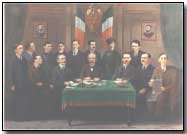I have mentioned this many times down through the years to Fine Gael people, they were always the best at condemning Adams and McGuinness and the IRA as cold blooded killers.
Mention the Killing of Noel Lemass and the excuses varied and the subject would change. Some of the answers were just unbelievable; it was one of the most savage killings ever.
Fine Gael never did want to hear about it, One point must be said Sean Lemass always treated the opposition with dignity, I am sure he did not find it easy at times on account of that episode in the countries history alone.

In the Irish Mail on Sunday of 3rd October, Dermot Bolger's review of Damian Corless's Irish Hospitals Sweeptstakes contains some remarkable claims. Joe McGrath, one of the leading lights of the Sweepstakes racket, as is well known, is also stated to have been 'Michael Collins's former enforcer and torturer'. More than that, Bolger alleges that Seán Lemass's brother Noel 'was tortured and murdered by McGrath'.
The murder of Noel Lemass is notable for the fact that it took place after the end of the Civil War, he being abducted in July 1923 and his dismembered body located at the Featherbed in the Dublin Mountains in October (the spot is marked by a monument). While it is accepted that Free State forces were to blame, I have never seen anyone mentioned by name as the killer, and although McGrath might have turned a blind eye, one wonders if he is being unfairly accused? Ulick O'Connor wrote in the Sunday Indo in 2002 that Noel Lemass was killed because of the mistaken belief that he had been involved in the murder of Sean Hales.
Those were indeed terrible times, and it is suspected that the Military Archives in Cathal Brugha Barracks may still hold some surviving secret files that just might throw a little more light on these officially sanctioned murders. You will still find the odd 'Blueshirt' justifying the killings today, in the cause of preserving order and democracy. Of course the Republicans killed ruthlessly as well and have their apologists, but they could not match the ferocity and resources of their former colleagues and friends in the Free State government.
The murder of Noel Lemass is notable for the fact that it took place after the end of the Civil War, he being abducted in July 1923 and his dismembered body located at the Featherbed in the Dublin Mountains in October (the spot is marked by a monument). While it is accepted that Free State forces were to blame, I have never seen anyone mentioned by name as the killer, and although McGrath might have turned a blind eye, one wonders if he is being unfairly accused? Ulick O'Connor wrote in the Sunday Indo in 2002 that Noel Lemass was killed because of the mistaken belief that he had been involved in the murder of Sean Hales.
Those were indeed terrible times, and it is suspected that the Military Archives in Cathal Brugha Barracks may still hold some surviving secret files that just might throw a little more light on these officially sanctioned murders. You will still find the odd 'Blueshirt' justifying the killings today, in the cause of preserving order and democracy. Of course the Republicans killed ruthlessly as well and have their apologists, but they could not match the ferocity and resources of their former colleagues and friends in the Free State government.




